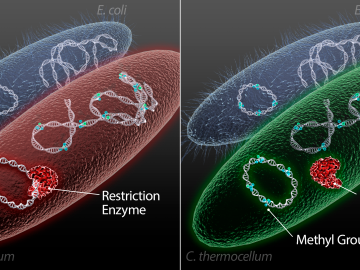
Filter News
Area of Research
- (-) Energy Science (43)
- (-) Materials (30)
- (-) National Security (11)
- Advanced Manufacturing (1)
- Biological Systems (2)
- Biology and Environment (73)
- Computational Biology (1)
- Computational Engineering (3)
- Computer Science (7)
- Fusion and Fission (1)
- Fusion Energy (1)
- Materials for Computing (5)
- Mathematics (1)
- Neutron Science (21)
- Nuclear Science and Technology (5)
- Quantum information Science (9)
- Supercomputing (86)
News Topics
- (-) Big Data (12)
- (-) Bioenergy (32)
- (-) Clean Water (10)
- (-) Molten Salt (3)
- (-) Quantum Science (13)
- (-) Summit (8)
- 3-D Printing/Advanced Manufacturing (92)
- Advanced Reactors (10)
- Artificial Intelligence (24)
- Biology (15)
- Biomedical (11)
- Biotechnology (5)
- Buildings (38)
- Chemical Sciences (33)
- Composites (19)
- Computer Science (50)
- Coronavirus (16)
- Critical Materials (19)
- Cybersecurity (26)
- Energy Storage (85)
- Environment (69)
- Exascale Computing (3)
- Fossil Energy (2)
- Frontier (3)
- Fusion (8)
- Grid (44)
- High-Performance Computing (13)
- Hydropower (3)
- Irradiation (1)
- Isotopes (13)
- ITER (1)
- Machine Learning (20)
- Materials (95)
- Materials Science (90)
- Mathematics (3)
- Mercury (3)
- Microelectronics (1)
- Microscopy (29)
- Nanotechnology (41)
- National Security (37)
- Neutron Science (44)
- Nuclear Energy (26)
- Partnerships (20)
- Physics (28)
- Polymers (21)
- Quantum Computing (3)
- Security (15)
- Simulation (4)
- Space Exploration (5)
- Statistics (1)
- Transportation (72)
Media Contacts

Scientists at the Department of Energy’s Oak Ridge National Laboratory have developed a new method to peer deep into the nanostructure of biomaterials without damaging the sample. This novel technique can confirm structural features in starch, a carbohydrate important in biofuel production.

A novel approach developed by scientists at ORNL can scan massive datasets of large-scale satellite images to more accurately map infrastructure – such as buildings and roads – in hours versus days.

An international team of researchers has discovered the hydrogen atoms in a metal hydride material are much more tightly spaced than had been predicted for decades — a feature that could possibly facilitate superconductivity at or near room temperature and pressure.

While Tsouris’ water research is diverse in scope, its fundamentals are based on basic science principles that remain largely unchanged, particularly in a mature field like chemical engineering.

A technology developed at the ORNL and scaled up by Vertimass LLC to convert ethanol into fuels suitable for aviation, shipping and other heavy-duty applications can be price-competitive with conventional fuels

Researchers at the Department of Energy’s Oak Ridge National Laboratory have received five 2019 R&D 100 Awards, increasing the lab’s total to 221 since the award’s inception in 1963.

The National Alliance for Water Innovation, a partnership of the Department of Energy’s Oak Ridge National Laboratory, other national labs, university and private sector partners, has been awarded a five-year, $100 million Energy-Water Desalination Hub by DOE to address water security issues in the United States.

Scientists at the US Department of Energy’s Oak Ridge National Laboratory have demonstrated a method to insert genes into a variety of microorganisms that previously would not accept foreign DNA, with the goal of creating custom microbes to break down plants for bioenergy.

Electro-Active Technologies, Inc., of Knoxville, Tenn., has exclusively licensed two biorefinery technologies invented and patented by the startup’s co-founders while working at the Department of Energy’s Oak Ridge National Laboratory. The technologies work as a system that converts organic waste into renewable hydrogen gas for use as a biofuel.

A new method developed at Oak Ridge National Laboratory improves the energy efficiency of a desalination process known as solar-thermal evaporation.


